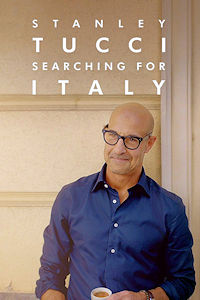 If you’re in the food world, particularly the Italian food world, it’s unlikely you’ve missed the much hyped new show, Stanley Tucci: Searching for Italy. The actor, writer, director promises to take us on a tour, region by region, of the country, exploring the best ingredients and recipes each has to offer. Let me just say this upfront… Tucci is kind of boring in this show. I’m sorry, but he is.
If you’re in the food world, particularly the Italian food world, it’s unlikely you’ve missed the much hyped new show, Stanley Tucci: Searching for Italy. The actor, writer, director promises to take us on a tour, region by region, of the country, exploring the best ingredients and recipes each has to offer. Let me just say this upfront… Tucci is kind of boring in this show. I’m sorry, but he is.
That whole dead-pan schtick is great in an acting role where he plays the foil to a comic actor, or just needs an affectless persona. But a tour guide with that demeanor just doesn’t cut it. It’s kind of a droning “on the right we’re passing X, on the left you can see Y, there’s also Z somewhere around here, but let’s just keep moving”. There’s no passion, no emotion, no excitement.
That said, much of the countryside, and definitely the food, speak for themselves, and where not, the people he encounters speak for them, and he’s bland enough to just ignore. I found that there were recipes, ideas, of stuff that I just haven’t encountered in my own travels in Italy – there’s always something new. And because I simply don’t have enough cooking projects (ha!) to present to you, I thought I’d pick one thing from each episode that caught my attention, and explore it further.
The first season has six episodes, out of, presumably, twenty planned. I figure two recipes per post will work just fine for these, and forego complete step-by-step photos – I imagine that most of those of you who would try these out will understand the intermediate points. If you don’t, drop me a line – I’ll send more detailed pictures!
Spaghetti alla Nerano
Episode 1 starts us off in Campania, the state that surrounds Naples. In a bizarre sequence, Tucci and his wife head to a hotel restaurant, Lo Scoglio, on a pier in Nerano, on the south coast, where they seem to have commandeered the entire restaurant in the midst of a raging storm, just to have the chef demonstrate a pasta recipe they’d tried once years before and never been able to duplicate. Mostly because they were completely wrong about both the ingredients and way to make the dish.
The first step, slice the zucchini fairly thinly, and then fry it in olive oil until it’s semi-browned.
Remove from the oil, and put in a bowl with just whatever oil clings to the zucchini pieces. While still hot, cover the bowl with cling film and then put it in the refrigerator… overnight. Now, why, I wanted to know? So I tried a small batch with some of the zucchini which I didn’t leave overnight and there’s a noticeable difference. Just out of the frying pan, the zucchini has a slightly bitter edge, with crispy bits and when you follow the rest of the recipe, you end up with the pieces of zucchini basically staying whole. Leaving it overnight to steam and then sit in its oil results in a really creamy sort of texture, and the bitter edge mellows out completely, plus, as you’ll see, the pieces almost dissolve into the sauce.
Next day (or, I suppose, you could fry the zucchini in the morning and make this at night), it’s a very simple setup. The zucchini, some butter, some sheep’s milk pecorino cheese, and dry spaghetti. Also salt and pepper, but let’s go with those as a given in most recipes.
Get your pasta water going – with a decent amount of salt in the water. In a skillet, put the zucchini with whatever juices and oil are in the bowl, a pinch of salt (no more than that, you have pasta water and the pecorino cheese to add more salt later on) and some grinds of pepper, over low heat, and just kind of keep stirring it around, mashing it, until it all falls apart. Then add a knob of butter, and really whisk these together to more or less get a zucchini butter. I could even see actually blending these with a stick blender once you add the pasta water.
While you’re cooking the zucchini down, drop the spaghetti into the pasta water and cook it to about 2 minutes short of the recommended time. When you’re at that point, add a couple of ladles of the pasta water (salty, but also now starchy) into the skillet, and again, whisk it together well to emulsify it a bit.
Scoop the spaghetti out of the pot and straight into the skillet, and finish cooking it the last minute or two in the sauce. It will absorb all that liquid and the sauce will cling to the pasta. If it still seems too al dente to you at that point, add another half ladle of the pasta water to it and keep going. Remove from the heat, grate the pecorino over it, toss it, and…
…serve it up on a plate. You can get fancy with your plating if you want. In the show, they added a big sprig of basil, which to me makes as much sense as adding a sprig of curly parsley used to to every plate in a restaurant in the US back in the 60s and 70s. Garnishes should be related to the food being served… hey, maybe a fried zucchini blossom! Instead, I just grated a little more cheese over the top, because… cheese.
Delicious and simple!
I decided to pair each of these recipes with a classic regional wine… but… not having access to most Italian wines here, I’m going with Argentine versions of each. One of the most important white wines of Campania is Fiano di Avellino, and coming out of Mendoza, we have both a regular and gran reserve version of Fiano from Bodega Caelum. It’s one of my favorite white wines in all of Argentina, so it was an easy choice to make. Medium bodied white with moderately high acidity, crisp green apple fruit, notes of hazelnut, white pepper, and a hint of coffee. Maybe the gran reserva was a bit over the top, especially as the buttery oak is a bit more noticeable than in the regular wine, for a simple pasta dish like this, but damn it’s good. It runs around 900 pesos, or slightly under $10/bottle, and the regular is less.
Frittata di rigaglie di pollo
On to Episode 2, and the state of Lazio, home of Rome! Roman cooking is famous for what’s sometimes referred to as “the fifth quarter”, a euphemistic way of referring to offal, innards. Tucci visits a trendy little restaurant, Santo Palato, where the young chef is using offal in really creative and interesting reinterpretations of classic Roman food. Combining a classic frittata though without potatoes (the traditional is very much like a Spanish tortilla de patatas) with a version of a local pasta sauce made with the rigaglie di pollo, or giblets of chicken.
Our mise-en-place (it’s okay to use the French term, Italian chefs use it too) consists of eggs, the liver, gizzards, and hearts from a couple of chickens (something to do with those packets you find inside the chicken and usually either throw out right away or freeze them for 2-3 years until you clean out the freezer and then throw them out), some white wine, some parmesan cheese, butter, garlic, parsley, and off-scene, salt, pepper, and olive oil.
Trim up all the giblets and dice them really finely – these are in cubes a little smaller than 1/4″ (about 5mm). Also mince the parsley leaves and the garlic.
Okay, without showing all the intermediate steps… Put half the butter and a splash of olive oil of roughly equal volume in a skillet and get it sizzling over medium heat. Add the gizzards, hearts, garlic, some salt and pepper, and sauté until golden. Add the liver and cook for about a minute. Add the wine and parsley and cook until the wine has basically evaporated, leaving a lovely sauce, which you could now toss with pasta water and a pasta, and I’ll probably do that at some point, because it’s amazingly good, but today… just set it aside for a few minutes.
Beat the eggs with some grinds of pepper, and a decent amount of grated parmesan. You won’t need to add salt to the eggs, the parmesan takes care of that, along with the sauce. Over low heat, put the other half of the butter and again, olive oil to match. When nice and hot, pour in the eggs. By the way, I really recommend a non-stick skillet for this, or, like they did in the show, do it in a little cast iron one and serve it in the skillet – though there she did a one-egg version of this, in a mini-cocotte type pot to serve as a small appetizer.
Just let it cook, not stirring it or anything, until it’s about 90% set. There should just be a little liquid egg mix still left on top, just enough to spoon the sauce all over it and have it set in. Cover with a lid and let it cook until done – probably about 3-4 minutes to set the top and finish browning the underside and edges.
And, either serve in the skillet, or, slide it out onto a plate. I suppose since there’s parsley in the dish, you could brighten it up a bit with some more sprinkled over the top, just for color, but not really necessary. Yum! And I really do want to go back and use this sauce on pasta. It also would be interesting, and more substantial, to try this with the really classic frittata romana with the potatoes and onions in it.
This one took some searching to get. The classic red grape of Lazio is Cesanese, and I was figuring I was going to have to go with one of the less traditional grapes. But an online search revealed that Bodega Domingo Molina makes a version of the wine, sometimes, which I assume means that in some years they either just bottle it for themselves and don’t sell it commerically, or they blend it into other wines. Part of their Yeta line, as best I could determine, this is pure Cesanese, and it certainly tastes like it – beautiful strawberry and red cherry fruit, with lots of peppery and even chili-like notes. It’s light to medium bodied wine with a fair amount of acidity, and it worked perfectly with this dish. It also required a trip to the other side of town to the only place I found online that carried it and had it in stock, and it also runs a slightly pricey (for Argentina) $1520 pesos, or around $16. But you know, worth it!
And that winds up our first two episodes. Next post, on to Bologna and Milan.
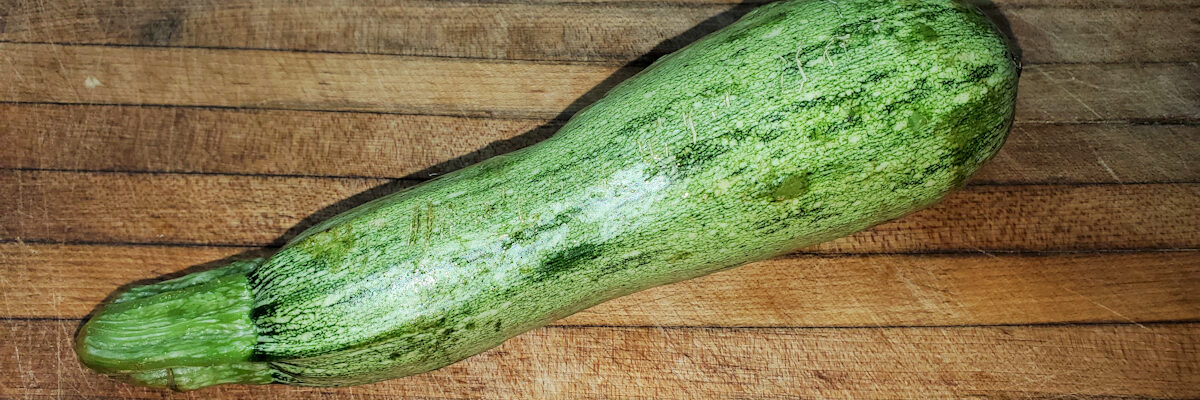
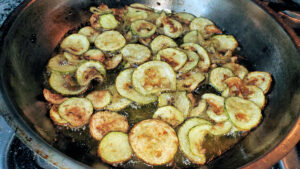
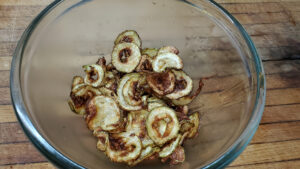
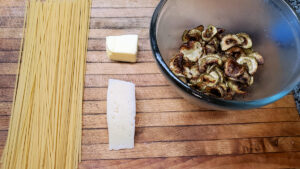
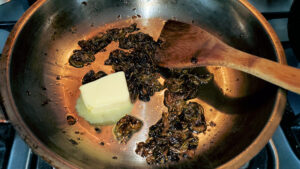
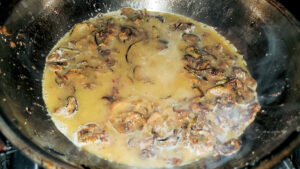
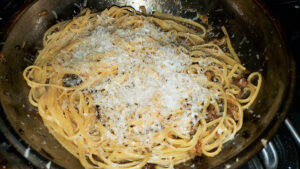
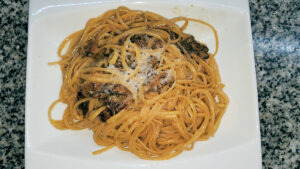
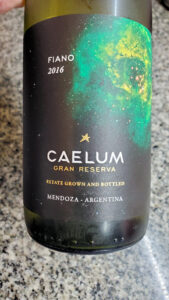
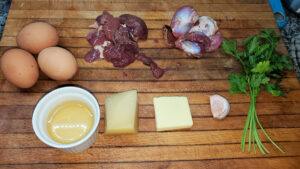
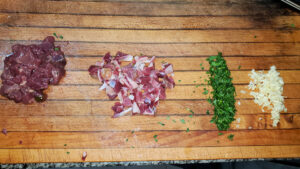
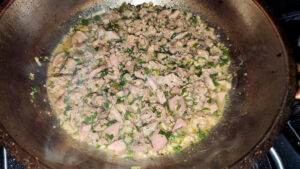
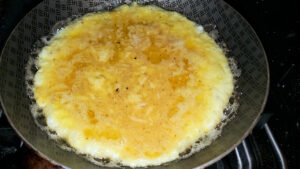
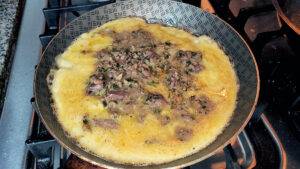
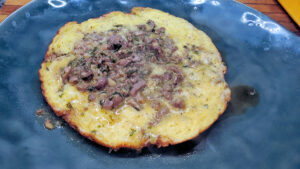
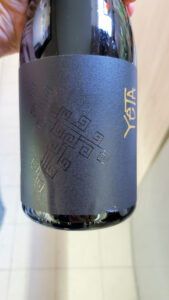
[…] This “project” is only going to have three entries this year, since the season of Stanley Tucci: Searching for Italy only has six episodes and I’m covering two in each post. Episodes 3 & 4, our man Stan travels to Emilia-Romagna and Lombardia, spending much of his time in the major cities of, respectively, Bologna and Milan. I like that he’s decided to hop around to states in different parts of the country rather than doing, say, all southern states first, and then another section, etc. It gives the overall season a more balanced feel. […]
[…] some delicious surprises along the way. Last year I featured two at a time in my write-ups, with Campania (Naples, Spaghetti alla Nerano) and Lazio (Rome, Frittata di rigaglie di pollo), then Emilia-Romagna (Bologna, Tagliatelle al ragú) and Lombardia (Lake Como, Riso con persico), […]